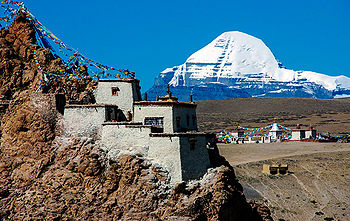Namkha Khyung Dzong

Namkha Khyung Dzong, in Tibet, is the name of a dharma encampment founded on the slopes of Mount Kailash, in Western Tibet, by Degyal Rinpoche, a main student of Dudjom Lingpa.
Origins
In 1904, after Dudjom Lingpa left this world, a group of disciples, including Degyal Rinpoche and Ling Lama Chöjor Gyatso, went to Pemakö to discove the new incarnation of their teacher, Dudjom Rinpoche, who was only three years old at that time.
After one month in Pemakö, Degyal Rinpoche left for a pilgrimage to Central Tibet and then after to Western Tibet.
Settling on the slopes of Mount Kailash, he spent most of his life in meditation. His cave became a small hermitage called Namkha Khyung Dzong and this hermitage gathered many disciples from various places of Tibet and Himalaya in order to receive teachings each summer, and to practice in strict retreat in caves during winter.
The Dudjom Tersar lineage became strongly established in this area, and took the name Dudjom Töluk, the Tibetan appellation for the Upper[1] tradition of Dudjom Tersar.
After the death of Degyal Rinpoche, his most famous disciple, Golok Serta Rinpoche, built a reliquary stupa to to keep the embalmed body of his master, and further developed the place into a monastery.
The Unrest Times
During the political turmoil, the monastery was completely destroyed by the Chinese. Degyal Rinpoche’s senior students carried the stupa of their master on their back and brought it to a refugees camp in India.
Recent Years
It seems that no rebuilding of the monastery in Tibet have begun up to now. But the Second Degyal Rinpoche have restablished a Namkha Khyung Dzong (Nepal) monastery in Nepal.
Notes
- ↑ Upper is for ‘Western Tibet’, and more precisely for the area of Mount Kailash.